"It’s not one of my favourite things. It’s stupid because I produced it, but the keyboards just hit me as wrong": Van Halen's Jump is 40 years old. Here's how the most famous keyboard riff of all time was created (and how you can do it, too)
Or the most irritating? You decide…

'De… da… de… de da daa-da… da da-de-de.' Just 11 keyboard stabs that will either send you into ecstasy or running to the hills. But whatever you think of the intro to Van Halen's jump, it is the most recognisable keyboard intro to any song ever. It is also to keyboard players, what the Smoke On The Water riff is to guitarists…
You enter that keyboard shop, find 'that' sound, you can't help yourself can you? Go on, no-one will notice, just start playing; it will be fun. Everyone in the shop will think you're cool! Now look at the shop assistants. They want to kill you.
Anyone who works in a music gear shop will tell you, if they hear either the intro to Van Halen's Jump or that riff from Smoke on the Water ever again, it will be too soon. As a keyboard player or guitarist, you might think you're the first person ever to play either riff, but the truth is you're the thousandth. Today.
Ok, here it is then…
The Jump story
But whatever you think about the intro to Jump – whether it is great or grating – you can't deny its impact. Jump topped the Billboard charts and was helped in no small part by that award-winning (but cheap) video. But it would be that intro keyboard line that the song would become most well known for.
Ed played me the riff and I went, ‘Uh… I don’t know. That’s so pop.
Jump producer Ted Templeman
Eddie Van Halen’s iconic synth riff was famously rejected by his bandmates when he first played it to them back in 1981. It took producer Ted Templeman to persuade frontman David Lee Roth of its merits, but even he wasn't initially bowled over by both the riff nor song.
Templeman told Guitar Player, “Ed played me the riff and I went, ‘Uh… I don’t know. That’s so pop.’" And he was even more direct in a Rolling Stone interview in 2020, stating, "It’s not one of my favourite things. It’s stupid because I produced it. But the keyboards just hit me as wrong."
Want all the hottest music and gear news, reviews, deals, features and more, direct to your inbox? Sign up here.
But after Roth was eventually persuaded to write some lyrics around the Ed riff, they had another hurdle to cross in that Templeman thought his lyrics were initially linked to a baying crowd encouraging a suicidal person to 'jump'.
"I said, ‘That sucks. That’s horrible," he told GP. "That sounds like somebody is going jump out of the window because he has so many issues.’ And Dave went, ‘No, “might as well jump” means for somebody to take a chance!’ So I said 'okay'."
The Jump keyboard notes and chords

The lyrics became more about taking risks and embracing life, and what better way to introduce them than in the most memorable synth line of all time? As good as Eddie's synth stabs were, he needed a powerhouse of a sound to do it justice, and fortunately he had access to a great source, the Oberheim’s OB-Xa, one of the first polyphonic synths with the ability to play 4, 6 or even eight voices at the same time.
Play it as simple or as complex as you like and you only need one hand to do it! Just don't play it near any music gear dealers
Not that you'll need all that polyphony. You can, if you like, play the Jump riff with single notes, all white, as: D, E, C, C, D, D, E, C, A, G, G. Or if you can play chords, just try the following: G major (G, B, D), C major (second inversion, G, C, E), F major x 2 (F, A, C), G major x 2 (G, B, D), C major (second inversion, G, C, E), F major (F, A, C), F major (second inversion, C, F, A), C major (C, E, G), and C second suspension (C, D, G).
There you go then: play it as simple or as complex as you like, and you only need one hand to do it! Just don't play it near any music gear dealers.
And as to the actual sound, let's explore some of the different ways to get the Jump keyboard synth timbre, from (very) expensive to (almost) free, along with a tutorial to program it yourself.
The Jump keyboard sound and where to get it
An original Oberheim OB-Xa
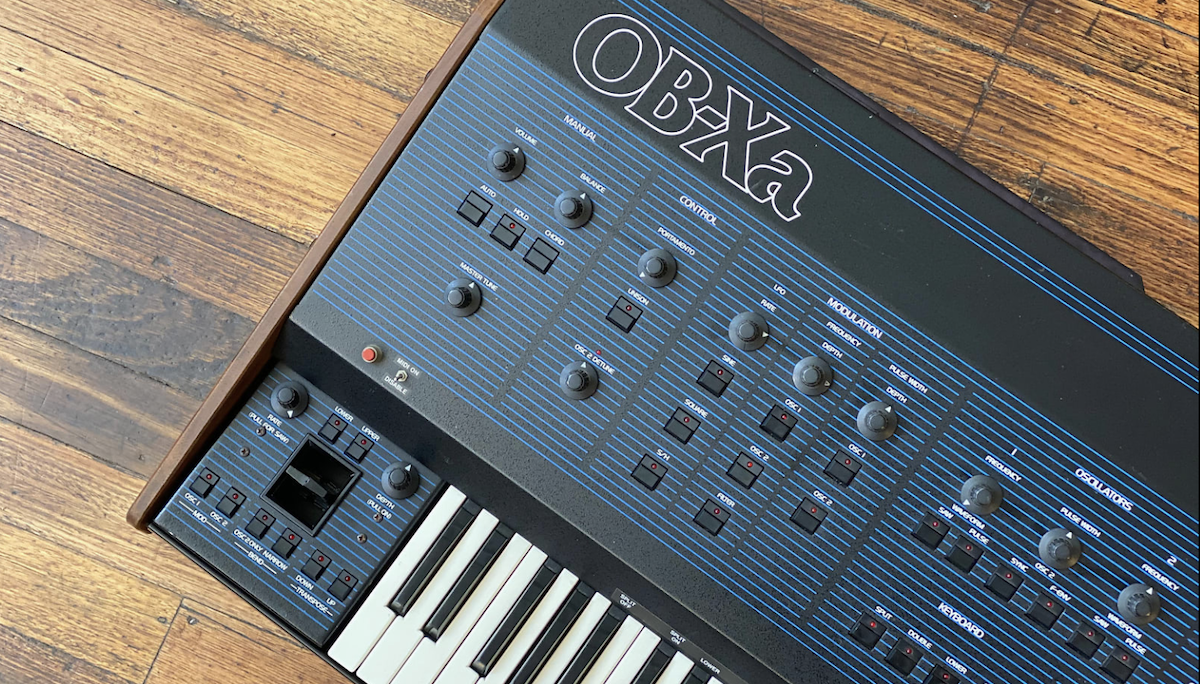
Look, you could go out and buy an Oberheim OB-Xa, at great cost, if you want the exact Jump keyboard sound. You'd be a fool, but you could do it. You will have to have rather deep pockets, because the latest secondhand prices for the machine are well into four or even five figures. You're talking at least £5,000/$6,000 and going right up to £12,000/$14,000 depending on the condition. Just to play one sound. Don't do it.
A new Oberheim OB-X8

And you could also go out and buy a new Oberheim like the fantastic OB-X8, also at great cost. You'd be a fool, but you could do it. Again, that's because the retail price for an Oberheim OB-X8 is close to that of the secondhand prices for the OB-Xa, around £4,500/$5,000.
It's an amazing synth, we can tell you. We use it to play just about every sound under the sun apart from the Jump synth sound, simply because it's banned in our house.
Other synth hardware

There are, in fact, many cheaper ways to get the Oberheim Jump sound in hardware – in fact if we're truly honest, you can wrestle a couple of slightly detuned sawtooth sounds out of most analogue and virtual analogue synths.
The Behringer UB-Xa (above) is one of the better bets, though, as it is essentially a clone of the original OB-Xa, and if you know the name Behringer, you will know that its version will be cheaper than the original. At around £1,200/$1,400 it is much cheaper, although still expensive for a Behringer.

Otherwise grab a good VA, or close to analogue synth like Novation's Summit (above), a flexible and great-sounding synth with lots of amazing sounds on top of that famous lead.
But really, in terms of getting that synth sound, your best bet is…
Software!
There are plenty of software options to get you the Jump sound, and again, any VA synth with a couple of oscillators should give you a close approximation. But to get the real deal Oberheim sound, go for any of these.

Sonic Projects OP-X Pro-II (Mac/PC) is an Oberheim OB-Xa clone with a list of ‘Famous’ presets that not only includes ‘Halen Jump’ but also ‘Radio Ga Ga’, ’99 Luftballons’ and ’Toto Africa Bass’ if you want to continue your '80s journey. It’s not cheap at $179 but currently cheaper on sale at €69. More info from the Sonic Projects website.

Arturia makes a couple of soft synths that will do the job, including a direct recreation of the OB-Xa in OP-Xa V (Mac, PC). It’s $149 or get it as part of V-Collection. More from here. The company’s Yamaha CS-80 recreation, CS-80 V (Mac/PC), also has a good stab at the sound – see what we did there? It's also $149 and there's more info here.

Synapse Audio's Obsession (Mac/PC) promises to be a very deep and realistic emulation of the original B-Xa, and is one of the cheaper software offerings at just £$79. There's more on this version at Synapse Audio's website.

Perhaps the greatest software recreations of Oberheims are made by GForce software, and they have a complete range of OBs that can all do Jump, available from £$50, or get the lot for £$249 (currently £$149). More info from the GForce website.

On the ‘free’ side of things, PC users can try Superwave P8 which is full to the brim of classic sounds. Click here for more. And Logic users can load in the 'Eighties Jump Brass' sound which is a very close approximation. Ok, Logic isn’t free (it’s £$199.99 from here) but you know what we mean.
Or for a very nearly free Jump experience, try the following tutorial to create the sound from scratch…
Program the jump sound yourself almost for free
If you are lacking a soft synth to make the Jump sound, do yourself a favour and go out and buy a copy of Computer Music magazine, which comes with a bundle of free software synths, instruments, drum machines and effects. One of the synths is called Dune CM. Load it up, follow this tutorial and you too will be Eddie Van Halen.

Step 1: To be honest, the Jump synth sound is quite easy to create. While the original used the mighty Oberheim’s OB-Xa, it barely scratched the surface of the synth's power. What the Oberheim’s OB-Xa did do was introduce a slight imprecision which we will duplicate with Dune CM.
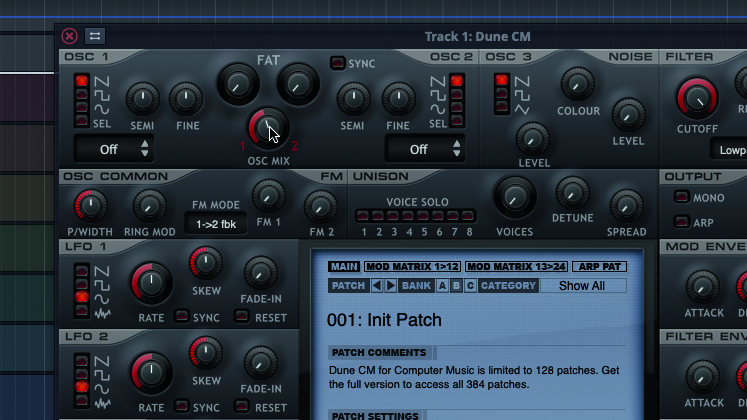
Step 2: In Dune’s central display, click the button accessing the B Bank, calling up an initialised patch. The oscillators, are set to produce sawtooth waves, the waves we want to use. Now set the Osc Mix dial to around 11 o’clock.
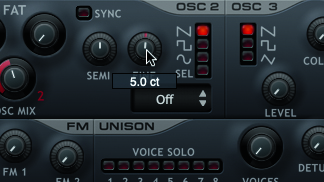
Step 3: The Oberheim OB-Xa had two oscillators, but each of its eight voices was a complete synth voice, and vintage calibration discrepancies meant they all sounded different, making chords sound huge. We can copy that with Dune. Setting the Fine Tune on Osc 1 to -5.0ct and the Fine Tune on Osc 2 to 5.0ct.
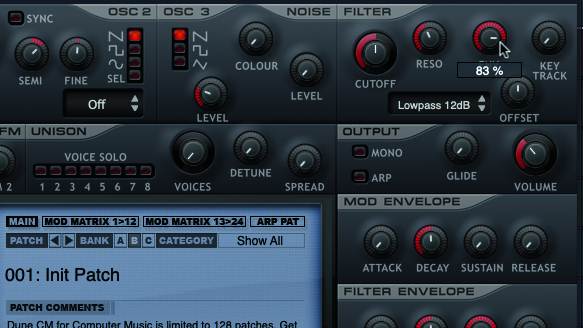
Step 4: Push Osc 2’s Semi knob to +12 (one octave up), and increase the Level of Osc 3 up to 26%. In the Filter section, set Cutoff at 50%, and Reso to 42%. Set the filter Env knob at around 83%.
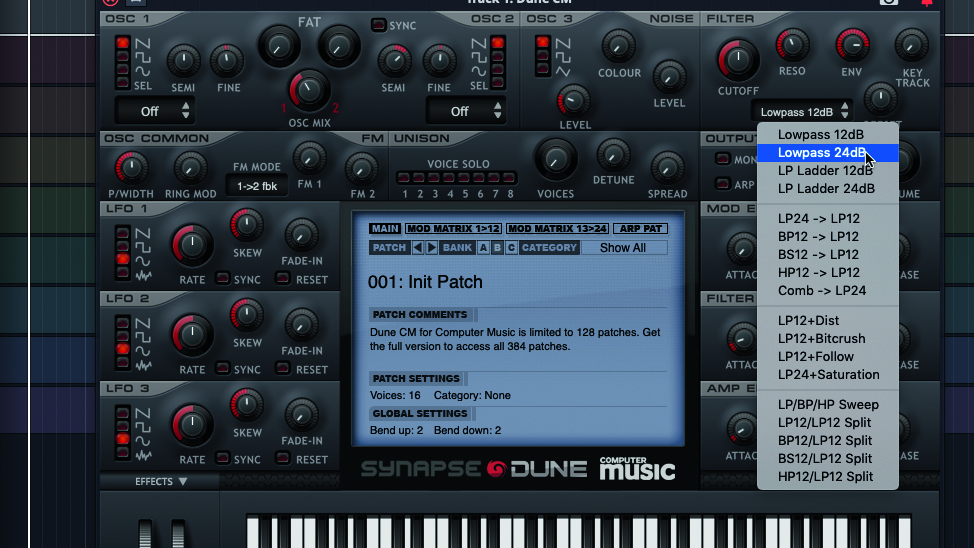
Step 5: We need a brassy overall sound. With the Amp Env, set the Attack to 7% and Release to 24%. With the Filter Envelope, set Attack at 12%, Sustain at 76% and Release at 19%. Switch the Filter mode to Low-pass 24dB.
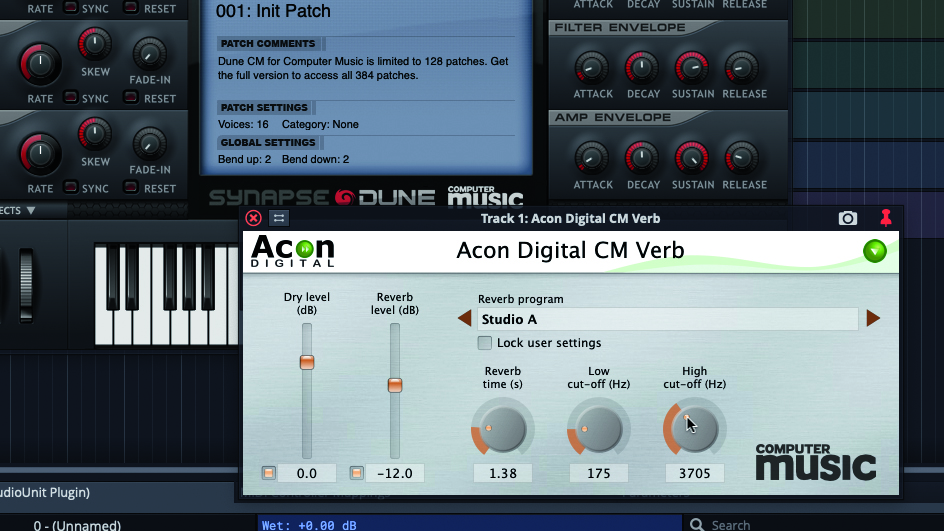
Step 6: Finally, add some reverb, courtesy of Acon Digital CM Verb and the Studio A program. Adjust the Reverb time, and Low and High Cut-off values. Now you have 'that' sound, and almost for free!


Andy has been writing about music production and technology for 30 years having started out on Music Technology magazine back in 1992. He has edited the magazines Future Music, Keyboard Review, MusicTech and Computer Music, which he helped launch back in 1998. He owns way too many synthesizers.
